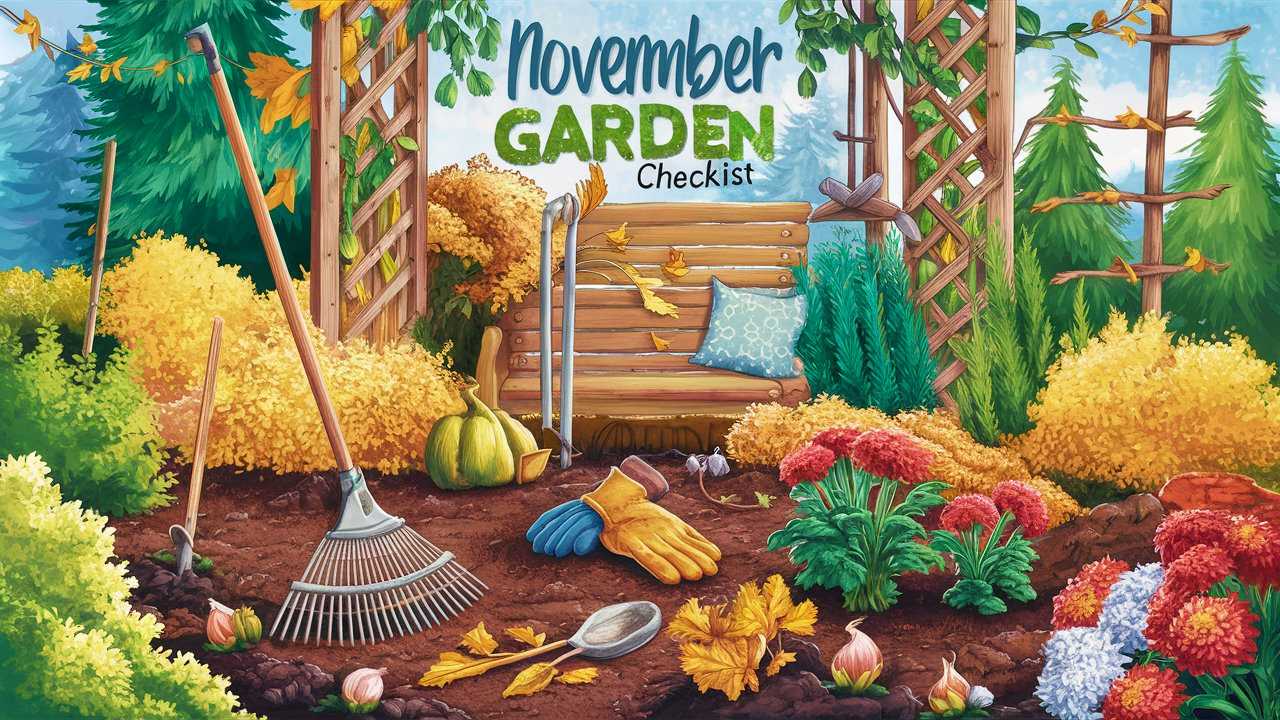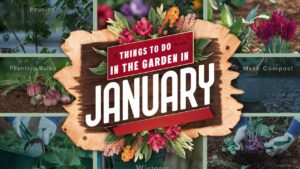As autumn fades away and winter edges closer, November is a transformative month in the garden. While many plants are going dormant, gardeners must pivot to new tasks that will prepare their outdoor oasis for the upcoming colder months or maximize the harvest of late-season crops. This detailed checklist will guide you through essential gardening tasks for November, ensuring a flourishing garden by spring.
Assess and Clean Up Your Garden
As blooming flowers and vibrant leaves make their exit, a solid cleanup prepares your garden for winter. Begin by removing any dead or dying plants. This is crucial not only for aesthetic reasons but also to prevent potential pests and diseases from overwintering in the debris. Rake up fallen leaves, especially those from diseased trees, and compost the healthy leaves while discarding the others to prevent the spread of disease.
Once the debris is cleared, take some time to assess your garden health. Look for issues like broken branches or any signs of disease on perennials. While the plants may be dormant, getting an early start on cleaning up can help mitigate problems when spring arrives.
Plan Your Next Year’s Garden
November is an optimal time for planning. With the cold weather coming, you’ll have some indoor time to sit down and sketch out your garden for the next year. Consider what worked well this past season and what didn’t. Evaluate the optimal sunlight, moisture, and nutrient needs of different garden areas.
Decide on crop rotations to improve soil health and reduce pest issues. Create lists for seeds you want to order and any plants you may want to add to your garden, including flowers, vegetables, and herbs. Research your local climate zones and choose varieties that will thrive in your particular conditions, ensuring a more productive and beautiful garden.
Prepare the Soil
Healthy soil is the backbone of a successful garden. November is an excellent time to prepare your garden beds for winter and the following spring. Start by testing the soil pH to understand its current state. Based on your findings, you may need to amend the soil with lime, sulfur, or organic matter to ensure proper nutrient availability.
Consider adding organic matter, such as compost or well-rotted manure, to enhance the soil structure. This will lead to better drainage and aeration, promoting root growth for spring planting. If you have empty garden beds, cover them with a layer of mulch or straw to protect the soil and prevent erosion during winter storms.
Plant Winter Crops
November offers a unique opportunity to plant certain crops that can withstand cooler temperatures. Garlic, for instance, thrives when planted in late autumn. This hardy bulb takes advantage of the winter chill and will be ready for harvest in the summer.
Onions, shallots, and certain varieties of winter greens, such as kale and spinach, can also be planted now for an early spring harvest. If you’re in a milder climate, consider planting cover crops such as clover or winter rye. These plants will improve soil health and prevent erosion while adding nutrients back into the ground.
Protect Your Plants
With the arrival of frost, it’s crucial to protect any tender plants from the chill. Use row covers, cloches, or even sheets to create a warmer microclimate for vulnerable plants. If you have plants in pots, consider moving them closer to the house or into a garage or shed to shield them from harsh winds and frost.
Perennials can be safeguarded by applying a thick layer of mulch around their bases. This insulates the roots and minimizes temperature fluctuations, increasing the likelihood of a healthy plant comeback in spring. Remember to check local frost dates to take timely precautions for your specific region.
Watering and Irrigation
Even though the temperatures are dropping, your plants still require sufficient water. November can be a dry month in many regions; thus, it’s essential to keep monitoring soil moisture levels. Make sure your plants are adequately hydrated before the first hard freeze, especially newly planted trees and shrubs.
For established gardens, reducing watering as temperatures drop is critical; overly soggy soil can lead to root rot. Ensure your irrigation systems are adequately prepared for winter, draining hoses and faucets to prevent freezing and damage. If you live in a particularly cold climate, it may be necessary to disconnect and store irrigation controllers and timers indoors.
Prune Trees and Shrubs
While most pruning is typically done in late winter or early spring, November can serve as an excellent time to prune certain trees and shrubs. This is particularly relevant for deciduous plants, as they are now in a dormant state, making it easier to see their structure without leaves. Remove any dead, damaged, or crossing branches to promote better airflow and reduce disease risk.
However, avoid excessive pruning of flowering shrubs or any plants that bloom on old wood, as this can diminish flower production. Instead, focus on shaping and encouraging a healthy growth habit. Remember to sanitize your tools between cuts to prevent disease transfer.
Maintain Garden Equipment
As the gardening season winds down, November is the perfect time to clean, sharpen, and maintain your gardening tools. Proper care of tools ensures that they remain in optimal condition for the next planting season and can help avoid spreading diseases between plants.
Start by clearing any soil, sap, or plant residue from your tools. A wire brush can effectively remove stubborn debris from metal surfaces. Once cleaned, it is crucial to sanitize tools using a solution of one part bleach to nine parts water; this will help eliminate any lingering pathogens.
Afterward, sharpen blades and pruners to ensure they make clean cuts next spring. Dull tools can lead to jagged edges that are susceptible to disease. Finally, store your tools in a dry area and consider applying a thin layer of oil to metal surfaces to prevent rust during the wet winter months.
Plan for Wildlife
As you prepare your garden for winter, consider the wildlife that may benefit from your efforts. Many gardeners overlook the importance of providing habitats and food sources for local birds and beneficial insects. Planting evergreen trees or shrubs can offer shelter for wildlife during the harsh winter months.
Additionally, consider setting up bird feeders filled with seeds and suet to keep birds nourished as natural food sources dwindle. If you have a water feature or birdbath, ensure it remains functional; continuously running water is less likely to freeze, providing a much-needed hydration source for wildlife.
Moreover, leaving some flower heads unpruned can provide food for birds, while hollow stems can serve as insect homes. Embracing nature in your garden not only supports local ecosystems but also enhances your gardening experience.
Create a Winter Garden Plan
While the garden may seem dreary in November, it’s an excellent opportunity to envision a winter garden space filled with beauty, interest, and structure. Think about incorporating winter-blooming plants such as hellebores or winter jasmine, which can provide color when much of the landscape is bare.
Consider hardscape elements like pathways, raised beds, or ornamental features that can add structure throughout the winter months. Designing a plan that includes evergreen foliage, strategically placed sculptures, and even outdoor seating can create a welcoming space for winter enjoyment. This forward-thinking approach prepares you to enjoy your garden year-round, regardless of the season.
Evaluate Your Compost
If you have a compost pile, November is an excellent time to evaluate its progress. Turn the pile to aerate and ensure it is decomposing efficiently. This will help prevent any unpleasant odors and improve the overall quality of your compost.
If you haven’t started composting yet, consider establishing a pile or bin now. November’s rainy season can accelerate the decomposition process, making it easier to create nutrient-rich compost for next spring. Include a mix of green materials (like kitchen scraps and fresh garden waste) and brown materials (like dried leaves and cardboard) to create a balanced mix.
As the cold sets in, ensure your compost is adequately insulated to prevent it from freezing if your climate exposes it to severe cold. This way, you will have a fantastic supply of compost ready to enrich your soil come spring.
Order Spring Bulbs
If you haven’t done so already, November is a prime time to order spring flowering bulbs before winter fully sets in. Daffodils, tulips, and hyacinths are just a few examples of what you can plant now for a beautiful spring display. Check local nurseries or reputable online retailers for the best available varieties suited for your climate.
When ordering bulbs, consider not only the aesthetics but also the practicality. Look for species that attract pollinators, bloom at varying times, and are perennial in your area. Planting a variety of bulbs will help ensure that your garden is vibrant and lively, welcoming back wildlife as they emerge from winter.
Attend to Indoor Plant Care
November marks a time when many gardeners transition their attention indoors. If you have houseplants, check their needs for humidity, light, and water. As indoor heating can dry out the air, using a humidity tray or misting plants can help maintain moisture levels.
Consider repotting any plants that have outgrown their containers. If you haven’t done so recently, inspect your plants for pests, such as spider mites or aphids, which can thrive in the warm shelter of your home. Taking preventative measures, like using neem oil or insecticidal soap, can help keep indoor plant pests at bay.
Moreover, now is the time to plan your indoor herb garden. Herbs like chives, parsley, and basil can do well in pots by a sunny window, offering fresh garnishes for meals throughout the winter months.
Mulch and Insulate Perennials
Protecting perennials during the winter is a priority as frosts threaten their survival. A generous application of mulch around the base of plants will provide adequate insulation to roots. Use organic material such as shredded leaves, straw, or wood chips.
Mulch not only protects but also can suppress weeds, which can prevent them from vying
continue
for nutrients and space once spring arrives. Be sure to apply a layer of mulch that is about 2 to 4 inches thick, leaving some air circulation around the stems to prevent rot. This insulation helps maintain a steadier soil temperature and moisture level, offering perennials the best chance to thrive through winter.
If you have particularly tender perennials, consider wrapping them in burlap or cloth to provide additional protection against harsh elements. You can also create windbreaks using stakes and garden fabric to shield delicate plants from icy winds. As winter approaches, these protective measures can significantly influence the health of your plants come spring.
Assess Your Garden Design
November is a wonderful month to step back and evaluate your garden’s structure and layout. With many plants devoid of foliage, the overall design becomes more visible. Take this opportunity to visualize the paths, borders, and zones within your garden.
Reflect on how you can improve upon the existing layout or introduce new elements in the following year. Consider aspects such as accessibility, visual interest, and color coordination. If you identified problem areas during the growing season—for instance, sections that received too little sunlight or drainage issues—now is the perfect time to address these considerations. Document your ideas through sketches or notes so you can implement these enhancements when the planting season arrives.
Check for Pest Management
While pests may not be as prevalent in November due to cooler temperatures, it’s essential to remain vigilant. Inspect your garden for any lingering signs of pests or diseases that may need attention before the ground freezes. Check underneath leaves, around stems, and on the soil surface.
If you find issues, address them promptly to prevent problems from worsening. This could mean applying horticultural oil or insecticidal soap if any remaining pests are spotted. Additionally, inspect your stored tools and equipment for signs of pests such as rodents or insects that may seek shelter over the winter in warm spaces.
Consider the possibility of implementing integrated pest management (IPM) strategies for next season. This may involve planting pest-resistant varieties, introducing beneficial insect habitats, or using all-natural repellents to keep unwanted guests at bay.
Prepare Your Garden Journal
A garden journal can be an invaluable resource for any gardener, helping you keep track of what worked and what didn’t throughout the growing season. Use November as the time to reflect on the year and update your journal with notes from your observations.
Record details regarding planting dates, growth rates, harvest times, and any problems encountered (and how you addressed them). This information is essential for future gardening endeavors, allowing you to make informed decisions about crop rotation, soil amendments, and pest management strategies.
Additionally, include photographs of your garden at its peak and reflect on how it evolved throughout the year. This can inspire your planning for the upcoming season, serving as a personal ledger of achievements and lessons learned.
Store or Dispose of Pots and Supplies
With the gardening season winding down, it’s crucial to clean and store any garden pots, trays, and other supplies. Wash terracotta pots to remove salt buildup and sanitize plastic pots to eliminate pathogens. Ensuring your pots are free from dirt and disease will extend their lifespan and prepare them for spring planting.
If you have broken or damaged pots, consider recycling or repurposing them into garden art or drainage layers for new pots. Declutter your garden shed by surveying other supplies such as fertilizers, stakes, and garden ornaments. Disposing of any old products or materials ensures that you have only what you need for the next planting season.
Consider Winter Sowing
For the adventurous gardener looking to jumpstart the growing season, consider winter sowing. This technique involves planting seeds in clear containers and placing them outdoors in the winter months. As snow and rain help with natural stratification, many seeds will germinate as the weather warms up, providing an early start to spring growth.
Choose seeds that benefit from cold stratification, such as some perennials and hardy annuals. Container gardening also provides the benefit of protecting the seedlings from harsh conditions initially. A good rule of thumb is to use recycled containers—like milk jugs or salad containers—cut in half to create mini-greenhouses.
Enjoy the Season
Lastly, November offers an important reminder to simply enjoy your garden, even as it enters a state of dormancy. Take time to walk through your space, appreciate the subtle beauty of skeletal branches, and reflect on previous seasons.
Utilize this period for creativity and inspiration as you plan for the next cycle of growth. Whether taking photos, sketching your layout on paper, or dreaming of colorful blossoms and bountiful harvests, immerse yourself in the peacefulness winter can bring to the garden.
With these comprehensive tasks in your November garden checklist, you can ensure your floral and vegetable gardens remain healthy and vibrant, laying the groundwork for a robust gardening year ahead. Embrace the unique opportunities that November provides, allowing the closure of one season to become the catalyst for the next.
























